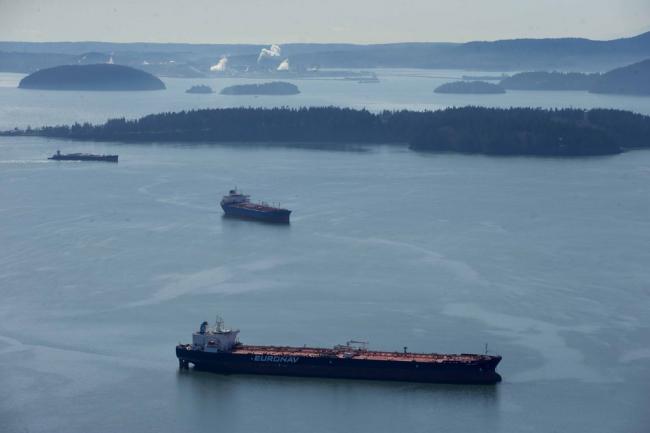Articles Menu

A tanker spill of diluted bitumen from Canada’s oils sands could trigger an ecological catastrophe for the Salish Sea. The oil would impact crab, rockfish and other bottom dwellers — as well as salmon and orca whales.
EVERY week, another barge or tanker traverses the narrow straits in the San Juan Islands, bearing a cargo of tar-sands crude oil from Canada headed for refineries. In order to flow through a pipeline to a port near Vancouver, B.C., the tar-like bitumen mined in Alberta is diluted with light hydrocarbons — thus it’s called diluted bitumen, or “dilbit.” And if a Kinder Morgan pipeline project receives Canadian approval, these weekly transits threaten to occur daily.
Were a dilbit spill to occur here, a portion might be corralled and removed by prompt action of the U.S. Coast Guard and local spill responders. But according to an authoritative report by the National Academies of Sciences and Engineering, some would likely sink to the sea floor and remain unrecoverable for decades, impacting crab, rockfish, sand lance and other bottom dwellers — as well as the salmon and orcas that ultimately depend on them in the food chain. A large dilbit spill could trigger an ecological catastrophe.

(Michael Riordan, co-author of “Crystal Fire and Tunnel Visions,” is a member of the board of directors of Friends of the San Juans.)
This dilbit threat is not confined to the Salish Sea. Many of the tankers would head south along the West Coast, offloading in California, where refineries can handle heavy oils. And a Tesoro terminal proposed on the Columbia River could also load a barge or tanker per day with tar-sands crude.
The Eastern Seaboard is not immune from the threat, either. The Energy East pipeline proposed by TransCanada could bring up to 1.1 million barrels of dilbit daily from Alberta to New Brunswick, leading to hundreds of gargantuan tankers a year lumbering down the East Coast. Besides the danger of sinking oils from spills, these tankers would transit commercial fisheries and whale habitats in the Gulf of Maine and off Cape Cod.
When dilbit enters water, it separates into the original tar-like bitumen and light diluents like benzene. This noxious, carcinogenic gas makes rapid spill-recovery efforts extremely difficult.
What happens in days after a spill is uncertain. Most research shows that some of the bitumen sinks, especially due to wind, waves or sediments. The end results appears to depend upon the dilbit composition plus weather and water conditions.
Many such questions were addressed by the National Academies report, which concluded that “spills of diluted bitumen pose particular challenges when they reach water bodies. In some cases, the residues can submerge or sink to the bottom.” Dilbit spills are also “highly problematic for spill response because there are few effective techniques for (its) detection, containment, and recovery.”
Asked about dilbit spills by U.S. Sen. Maria Cantwell, D-Wash., during a Senate hearing, the U.S. Coast Guard commandant, Adm. Paul Zukunft, testified that “once it settles to the sea floor, our technology is lacking.”
But during the Stephen Harper administration, Canadian regulators ignored the National Academies report in reviewing the Kinder Morgan project, claiming that it was published too late and would be “prejudicial” if considered. This is an irresponsible position that ignores the best available scientific information on the behavior of diluted bitumen in marine environments.
Or will they instead recognize that the dilbit threat may eventually affect all our coastal waters? If so, they should call a moratorium on marine transport of diluted bitumen until the behavior of such spills is better understood and adequate recovery methods are developed.
[Top photo: Oil tankers in Samish Bay near the San Juan Islands in 2014 (ERIKA SCHULTZ/THE SEATTLE TIMES)]